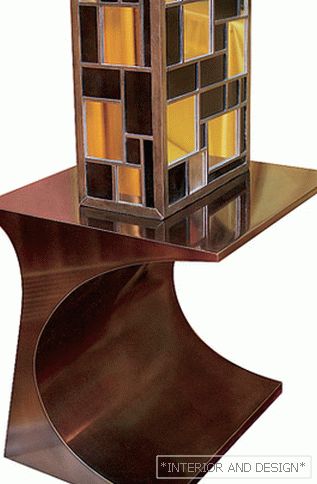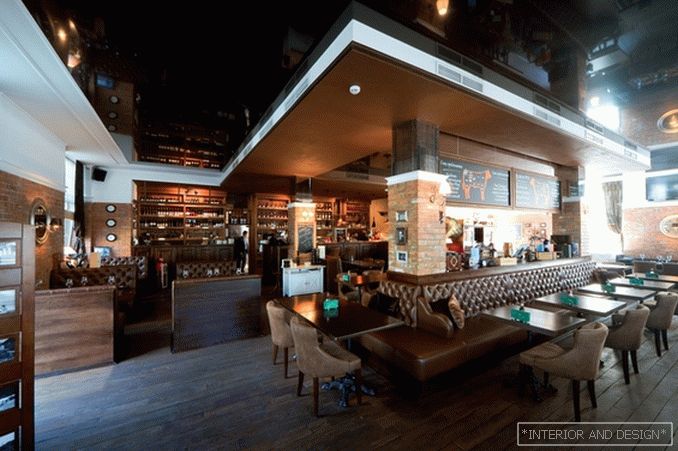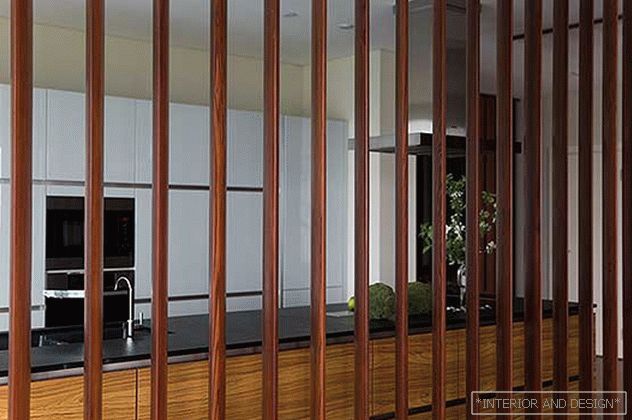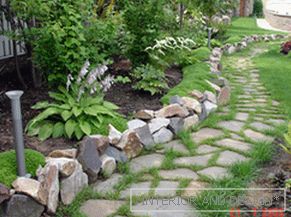 Garden paths embody the beauty and harmony of the suburban area. They perform a decorative function and are an integral element of modern landscape design. Making a track with your own hands is easy, you need to select the appropriate material and familiarize yourself with the installation procedure. The tracks will give your site an individual and unique look.
Garden paths embody the beauty and harmony of the suburban area. They perform a decorative function and are an integral element of modern landscape design. Making a track with your own hands is easy, you need to select the appropriate material and familiarize yourself with the installation procedure. The tracks will give your site an individual and unique look.
Content
- 1 Varieties of garden paths
- 1.1 Gravel paths
- 1.2 Ground
- 1.3 Monolithic
- 1.4 Butt end
- 1.5 From concrete slabs
- 1.6 From rubble
- 1.7 Grass Paths
- 2 Design options for garden paths
- 3 DIY gardening
- 4 Photos of different options for garden paths
Varieties of garden paths
Garden paths differ in material, size and pattern. Choose a track should, given the style of a country house.
The tracks on the site depending on type of material can be:
- gravel;
- ground;
- brick;
- monolithic;
- face;
- tiled;
- crushed stone;
- herbal
Each of them has its advantages and disadvantages.
Gravel paths
Gravel cover is undesirable to use where it can drop in. car or garden tractor. Fallen leaves to remove from the gravel is very difficult, so you in this case can only special garden vacuum cleaner. Along with the disadvantages, you can highlight and advantages gravel path:
-
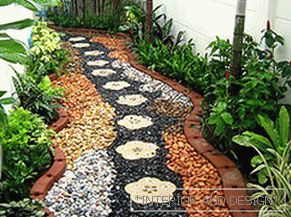 varied decor;
varied decor; - resistant to wet weather (no blurring occurs);
- long service life;
- simple installation.
If the load on the track is minimal, then gravel is an excellent budget solution.
Ground
Brick is the most common material for builders, so brick laying the track - the most optimal and budget option. The track can be laid out in different ways and use different colors. A simple building brick for a walkway will not be very durable. Better to use clinker brick. It is made by firing special clay. This path will last a long time and it does not require special care.
Monolithic
Monolithic garden paths are the most versatile. Because of their durability, they are in great demand among gardeners. Made of monolithic concrete and are the simplest and most profitable material for summer residents. Concrete is treated with special chemicals. With it, you can create various options for laying the track on the site.
Butt end
 End tracks are popular for their environmentally friendly materialy They are made of cuts, cuts, boards or plates. Different mosaic version of laying the end track looks great in the landscape design of a country house. It is pleasant to walk on it and after the rain it is not very slippery. Before laying wood is treated with special protective agents so that over time the path does not rot.
End tracks are popular for their environmentally friendly materialy They are made of cuts, cuts, boards or plates. Different mosaic version of laying the end track looks great in the landscape design of a country house. It is pleasant to walk on it and after the rain it is not very slippery. Before laying wood is treated with special protective agents so that over time the path does not rot.
From concrete slabs
The path of concrete slabs can be laid from a material of different sizes and colors. This will give the garden plot a unique look. To diversify the style of the site, concrete slabs are combined with brick or stone. Decorative concrete will cost 2 times more than normal. You should also take care of it, since it can peel off around the edges, each year you should protect the surface with a special varnish. If you do not take any measures to update the surface, the track will lose its former beautiful appearance.
From rubble
Garden paths from rubble can be selected according to your individual preferences and design of a country house. There is a large selection of color shades on the market that can be varied with each other during installation. The advantages of the rubble path are that able to withstand heavy loads, after the rain does not remain puddles. However, the tracks of marble and limestone are undesirable to lay in the place of the site where there is a shadow. Over time, the path may become covered with bloom, and this will spoil the appearance of the garden plot. In these places it is better to use tracks of quartz and granite.
Grass tracks
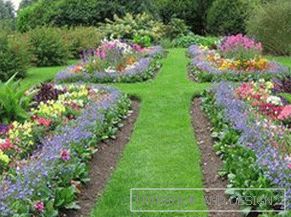 Grass tracks очень эстетично и богато выглядят, но за ними требуется serious care. Unlike stone and concrete paths, they do not heat up in summer, absorb dust and contribute to the production of oxygen. They can be used not only as footpaths, but also as access routes, suitable for any design and style of the garden plot, they come in various shapes and lengths.
Grass tracks очень эстетично и богато выглядят, но за ними требуется serious care. Unlike stone and concrete paths, they do not heat up in summer, absorb dust and contribute to the production of oxygen. They can be used not only as footpaths, but also as access routes, suitable for any design and style of the garden plot, they come in various shapes and lengths.
As seeds, meadowgrass, white benthole, meadow and red fescue and other plants that are resistant to trampling are commonly used.
disadvantages these types of paths: inconvenience after rain (the ground is soaked and the grass path becomes wet), sooner or later there are bald spots and the path is trampled down. In the summer you will need to mow often enough But these problems can be solved. From trampling down, you can use special lawn gratings that do an excellent job with large loads and do not impede the growth of grass. To avoid inconvenience after rainy weather, you can lay a paved and concrete path near the entrance to the fence.
Garden path design options
After you have decided on the choice of material for the track, you need to take a responsible approach to it. design. After all, how the track is laid, the whole look of your site depends.
Wooden cuts of any size are laid in different ways: it is possible in a chaotic manner, from large cuts to small ones, etc. The gaps between the cuts are usually filled with tiles. It needs to be crushed. Old boards or boards can be laid out in rainbow color.
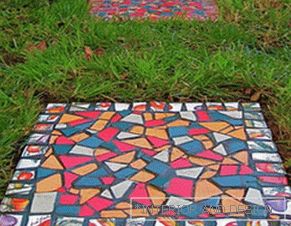 Concrete slabs can be laid with stones in the form of a mosaic. It can be the most uncomplicated patterns, ranging from simple ornaments (flowers, petals), ending with a complex mosaic (wriggling lines and waves). Concrete slabs are perfectly combined with brick, decorative stones and metal gratings.
Concrete slabs can be laid with stones in the form of a mosaic. It can be the most uncomplicated patterns, ranging from simple ornaments (flowers, petals), ending with a complex mosaic (wriggling lines and waves). Concrete slabs are perfectly combined with brick, decorative stones and metal gratings.
Path of dark stones, on the sides can be arranged colored pebbles and fill it up with gaps.
Brick garden path will look beautiful staggered or in step form. Perfect for the site, made in oriental style.
DIY gardening
Before you build the track you need to start with the planning. Where the path should be laid and how many should be. Next, we define track width. As a rule, two people walking along should be placed on the walkway. Therefore, its width should be 1 or 1.5 meters. If the path is intended for passage to the beds and the garden, the width may be 0.5−0.9 meters. Many tracks will not look aesthetically pleasing and, if they are not intended for anything, then their use is not appropriate.
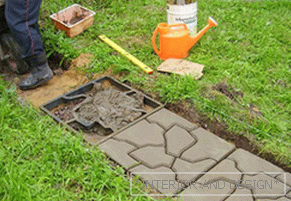 The coating material is hard, soft and combined. For solid tracks use brick, concrete, wood. Soft coatings are built from rubble, chips and sand, and combined coatings combine, for example, concrete and rubble, brick and sand
The coating material is hard, soft and combined. For solid tracks use brick, concrete, wood. Soft coatings are built from rubble, chips and sand, and combined coatings combine, for example, concrete and rubble, brick and sand
Each path has its component parts: a pillow, a cover itself, a drainage system and a curbstone. Main tools and materials for work:
- sandstone;
- sand (8−10 buckets);
- cement;
- shovel;
- rope;
- pegs;
- laika;
- bucket;
- point;
- boards for formwork;
- trowel;
- film.
The technology of building a garden path has several stages. First you need to do marking of the territory. With the help of a peg and a stretched rope, outline the track layout. Next shovel go around the perimeter of the track for the presence of the roots of bushes and trees. If this is not done, the roots may harm the coating.
After the earth is dug out, dimple the ram Трамбовокой. Then sand is poured on every meter of the track. To keep the surface of the sand layer even, a rule should be used. Water is poured onto the sand for better tamping. It is advisable to compact small areas of 10 cm. Ultimately, the surface should be convexso that the water flows better. Sand pillow should reach 8−15 cm in thickness.
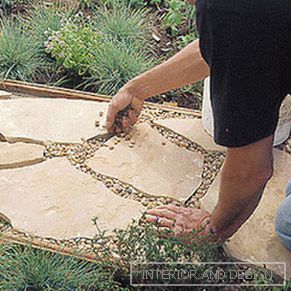 The next step in the construction of the track is laying sandstone. For convenience, you can bring it in a wheelbarrow. Spread stones in different ways, for example, small pebbles in the middle, and large ones on the sides. Do not forget to leave a gap between them. Sandstone can be laid in two ways: dry and laying on a concrete base.
The next step in the construction of the track is laying sandstone. For convenience, you can bring it in a wheelbarrow. Spread stones in different ways, for example, small pebbles in the middle, and large ones on the sides. Do not forget to leave a gap between them. Sandstone can be laid in two ways: dry and laying on a concrete base.
With the dry method, take cement and mix it with sand. Spread this mixture on well rammed sand. Sandstone slabs laid out one after another. The small space between the plates should be well tamped with your fingers. Then you need to pour plenty of stones laid. We cover the path with a film so that the solution does not crack and does not harden so quickly. Walking on the finished track will be in a week.
Virtually any material fit in this way. You can use stones of various colors and sizes, make beautiful patterns, but this will take a lot of time.

